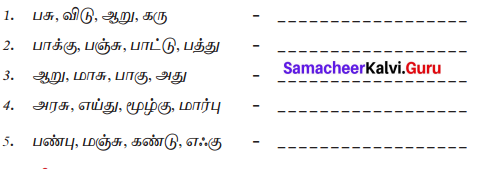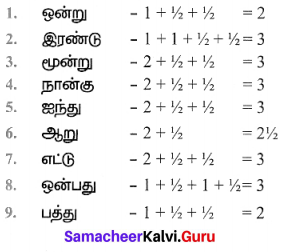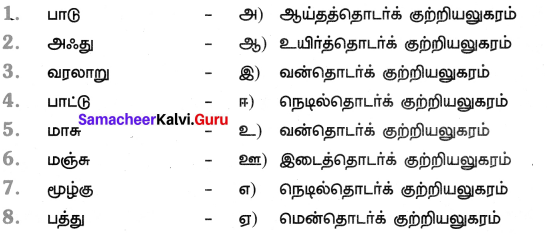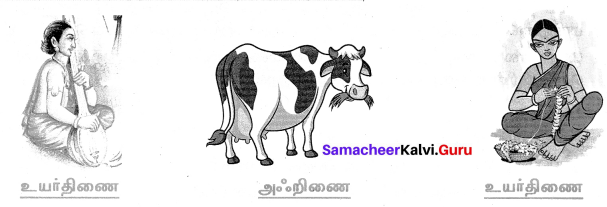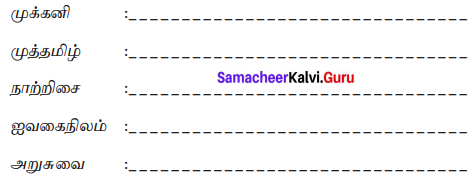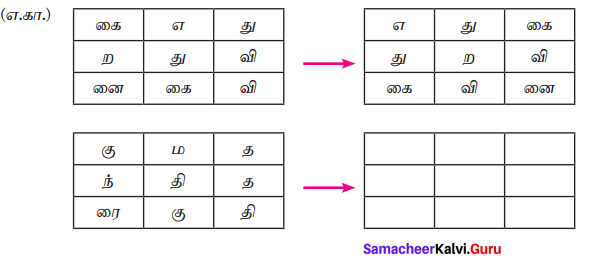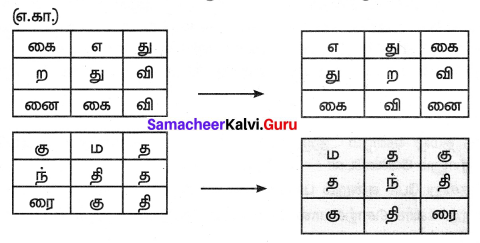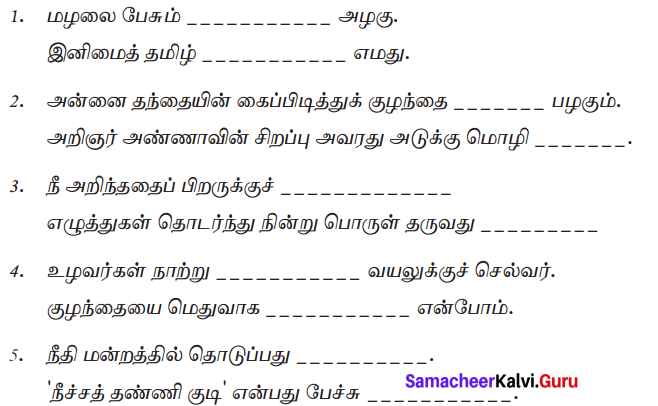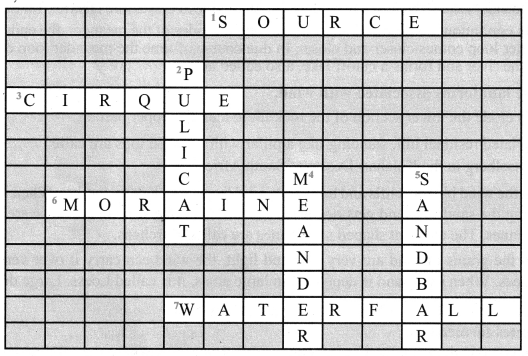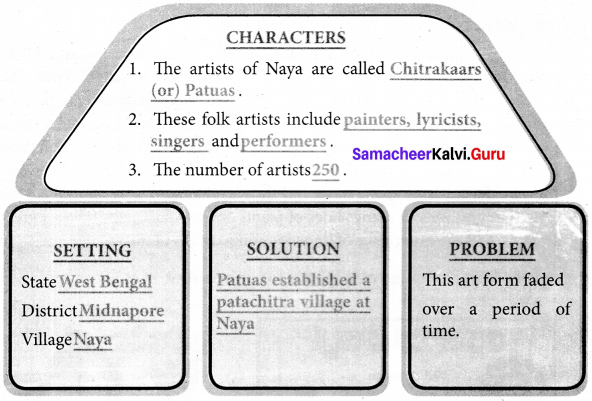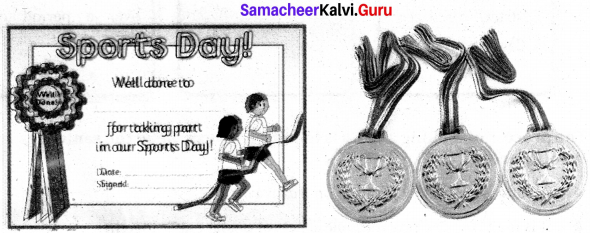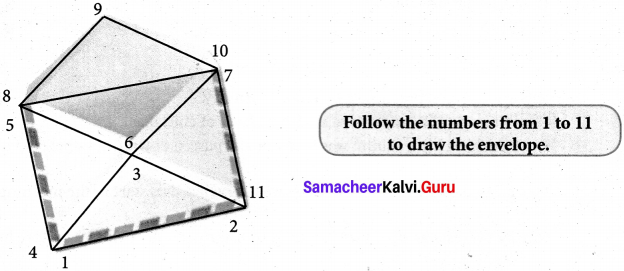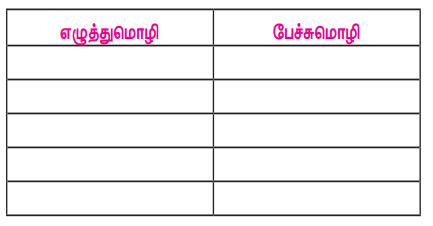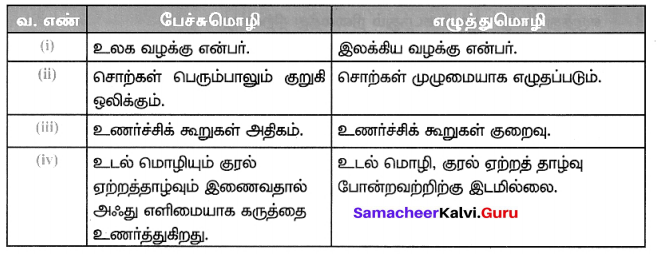Students can Download Tamil Chapter 1.5 அணி இலக்கணம் Questions and Answers, Summary, Notes Pdf, Samacheer Kalvi 7th Tamil Book Solutions Guide Pdf helps you to revise the complete Tamilnadu State Board New Syllabus and score more marks in your examinations.
Tamilnadu Samacheer Kalvi 7th Tamil Solutions Term 3 Chapter 1.5 அணி இலக்கணம்
மதிப்பீடு
குறுவினா
Question 1.
உவமை, உவமேயம், உவம உருபு விளக்குக.
Answer:
ஒரு சொல்லை மற்றொரு சொல்லோடு ஒப்பிட்டுக் கூறுவது உவமை அல்லது உவமானம் ஆகும். உவமையால் விளக்கப்படும் பொருள் உவமேயம் ஆகும். உவமை உவமேயம் இரண்டுக்கும் இடையில் வரும் உருபு உவம உருபு ஆகும்.

Question 2.
உவமை அணிக்கும் எடுத்துக்காட்டு உவமை அணிக்கும் உள்ள வேறுபாடு யாது?
Answer:

கற்பவை கற்றபின்
பின்வரும் தொடர்களில் உள்ள உவமை, உவமேயம், உவம உருபு ஆகியவற்றைக் கண்டறிந்து எழுதுக.

கூடுதல் வினாக்கள்
நிரப்புக.
1. அணி என்னும் சொல்லுக்கு அழகு என்பது பொருள்.
2. ஒரு செய்யுளைச் சொல்லாலும், பொருளாலும் அழகு பெறச் செய்தல் அணி எனப்படும்.
3. போல, புரைய , அன்ன, இன்ன, அற்று, இற்று, மான, கடுப்ப, ஒப்ப, உறழ போன்றவை உவம உருபுகள் ஆகும்.
4. ஒரு பாடலில் உவமையும் உவமேயமும் வந்து உவம உருபு வெளிப்படையாக வந்தால் அது உவம அணி எனப்படும்.
5. ஒரு பாடலில் உவமை ஒரு தொடராகவும் உவமேயம் ஒரு தொடராகவும் வந்து உவம உருபு மறைந்து வந்தால் அது எடுத்துக்காட்டு உவமை அணி எனப்படும்.
6. உலகில் இல்லாத ஒன்றை உவமையாகக் கூறுவது இல்பொருள் உவமை அணி ஆகும்.
விடையளி :
Question 1.
வமையணி விளக்குக.
Answer:
அணி விளக்கம்: ஒரு பாடலில் உவமையும், உவமேயமும் வந்து உவம உருபு வெளிப்படையாக வருவது உவமையணி ஆகும்.
அணி அமைந்த பாடல்:
அகழ்வாரைத் தாங்கும் நிலம்போலத் தம்மை
இகழ்வார்ப் பொறுத்தல் தலை.
பாடல் பொருள் : பூமி தன்னைத் தோண்டுபவரைப் பொறுத்துக் கொள்வதுபோல நாம் நம்மை இகழ்ந்து பேசுபவரைப் பொறுத்து கொள்ள வேண்டும்.
அணி பொருத்தம் : பூமி தன்னைத் தோண்டுபவரைப் பொறுத்துக் கொள்ளுதல் என்பது உவமை. நாம் நம்மை இகழ்ந்து பேசுபவரைப் பொறுத்துக் கொள்ள வேண்டும் என்பது உவமேயம். போல’ என்பது உவம உருபு.
Question 2.
எடுத்துக்காட்டு உவமையணி விளக்குக.
Answer:
அணி இலக்கணம் : உவமை ஒரு தொடராகவும் உவமேயம் ஒரு தொடராகவும் வந்து உவம உருபு மறைந்து வருவது எடுத்துக்காட்டு உவமை அணி ஆகும்.
எ.கா. :
தொட்டனைத்து ஊறும் மணற்கேணி மாந்தர்க்குக்
கற்றனைத்து ஊறும் அறிவு.
பாடலின் பொருள் : மணற்கேணியில் தோண்டிய அளவிற்கு நீர் ஊறும். மனிதர்கள் கற்கும் அளவிற்கு ஏற்ப அறிவு பெருகும் என்பதாகும்.
அணி பொருத்தம் :
தொட்டனைத்து ஊறும் மணற்கேணி என்பது உவமை.
மாந்தர்க்குக் கற்றனைத்து ஊறும் அறிவு என்பது உவமேயம்.
இடையில் அதுபோல ன்னும் உவம உருபு மறைந்து வந்துள்ளது.
Question 3.
இல்பொருள் உவமையணி விளக்குக.
Answer:
அணி இலக்கணம் : உலகில் இல்லாத ஒன்றை உவமையாகக் கூறுவது இல்பொருள் உவமை அணி ஆகும்.
எ.கா. :
1. மாலை வெயிலில் மழைத்தூறல் பொன்மழை பொழிந்தது போல் தோன்றியது.
2. காளை கொம்பு முளைத்த குதிரை போலப் பாய்ந்து வந்தது.
அள்ளி பொருத்தம் : உலகில் பொன் மழையாகப் பொழிவது இல்லை, கொம்பு முளைத்த குதிரையும் இல்லை. இவ்வாறு உலகில் இல்லாத ஒன்றை உவமையாகக் கூறப்பட்டதால் இல்பொருள் உவமையணிக்குச் சான்றாயின.
மொழியை ஆள்வோம்
கேட்க.
புகழ்பெற்ற கவிஞர் ஒருவரது உரையின் ஒலிப்பதிவைக் கேட்டு கிழ் . மாணவர்கள் தாங்களாகவே புகழ்பெற்ற கவிஞர் ஒருவரது உரையின் ஒலிப்பதிவை கேட்டு மகிழ வேண்டும்.
கீழ்க்காணும் தலைப்புகளுள் ஒன்று பற்றி இரண்டு நிமிடம் பேசுக
Question 1.
நான் விரும்பும் கவிஞர்.
Answer:
நான் விரும்பும் கவிஞர் – மகாகவி பாரதியார் :
நான் விரும்பும் கவிஞரான பாரதியாரைப் பற்றிப் பேச வந்துள்ளேன். இந்தியத் தாயின் மடியில் ஆனந்தமாய்த் தவழ வேண்டிய நாம் அடிமைகளாய்ச் சுருண்டு கிடந்ததைப் பொறுக்காமல், நம்மை மீட்க நம்மிடையே சுதந்திர உணர்வையும் எழுச்சியையும் வீரம் மிகுந்த தன்னுடைய பாடல்களால் ஏற்படுத்தியவர் பாரதியார். இவர் சாதி, மதம், இனம், மொழி, மத வேறுபாடுகளின்றி அனைவரையும் தம் பாடல்களினால் ஒன்றிணைத்தவர்.
மகாகவி பாரதியார் தூத்துக்குடி மாவட்டம் எட்டையபுரத்தில் 1882 ஆம் ஆண்டு டிசம்பர் கு 11 ஆம் தேதி சின்னசாமி ஐயர் – இலக்குமியம்மாள் தம்பதியருக்கு மகனாகப் பிறந்தார். இவரது இயற்பெயர் சுப்பிரமணியன் ஆகும்.
தன் இளம் வயதிலேயே தமிழில் கவிதைகள் பாடி அனைவரையும் கவர்ந்தவர். இவரது 16ஆவது வயதிலேயே எட்டையபுரம் அரசவையில் கவிதை பாடி பட்டத்தைப் பெற்றார். பாரதி என்றால் கலைமகள் என்பது பொருளாகும். தமிழ், வடமொழி, ஆங்கிலம் என்ற பல மொழிகளில் தன் புலமையினை மேம்படுத்திக் கொண்டவர்.
பாரதியாரின் உள்ளத்தில் விடுதலை வேட்கை எப்போதும் கொழுந்து விட்டு எரிந்து கொண்டே இருக்கும். அதன் வெளிப்பாடே அவருடைய பாடல்கள். அவர் தம் பேச்சாலும் எழுத்தாலும் விடுதலை வேட்கையைத் தூண்டியவர். அதுமட்டுமா? வ.உ.சி. சுப்பிரமணிய சிவா முதலான விடுதலைப் போராட்ட வீரர்களுடன் சேர்ந்து விடுதலை பற்றியே கலந்துரையாடுவார். விடுதலைப் போராட்டத்தில் முழு மூச்சாக ஈடுபட்டார். அவர் பாடிய பாடல்களும் கட்டுரைகளும் விடுதலையைப் பற்றி மட்டுமே எதிரொலித்தன.
பாரதியாருடைய அகன்று விரிந்த விசாலப் பார்வை இந்திய நதிகளை இணைத்தது. மாநிலங்களை இணைத்தது. அதற்குச் சான்று சிந்து நதியின் மிசை நிலவினிலே…. என்ற பாடல் வரிகள் தான். கங்கை நதிப்புறத்துக் கோதுமையைப் பெற்றுக் கொண்டு, காவிரி வெற்றிலையை மாறு கொள்வோம்’ என்று பாடியுள்ளார்.
இந்தியாவின் ஒன்றுபட்ட நிலைக்குத் தமிழ்ச் சமுதாயம் இணைந்து செயல்பட தம் பாடல்களைப் பார் முழுவதும் பரவச் செய்தவர் பாரதியார். இவர் விடுதலைப் போராட்டக் காலத்தில் மக்களை நோக்கி, இந்த நாடு நம் எல்லோருக்கும் சொந்தம், நாம் எல்லோரும் இந்த நாட்டுக்குச் சொந்தம் என்று பாடினார்.
பாரதியார் நம்பிக்கையின் மறு உருவம் என்று சொன்னால் அது மிகையாகாது. ஏனெனில் இந்தியா விடுதலை கிடைப்பதற்கு முன்பாகவே
“ஆடுவோமே பள்ளுப் படுவோமே
ஆனந்த சுதந்திரம் அடைந்துவிட் டோமென்று” – என்று ஆடிப் பாடினார்.
பல மொழிகளைக் கற்றறிந்த பாரதி, “யாமறிந்த மொழிகளிலே தமிழ்மொழி போல் இனிதாவ தெங்கும் காணோம்” என்று தமிழ் மொழியின் சிறப்பை எடுத்துரைத்துள்ளார்.
சாதிக் கொடுமைகள், பெண்ணடிமை, சமூக ஏற்றத்தாழ்வுகள் என்று அனைத்தையுமே இந்நாட்டிலிருந்து நீக்க வேண்டும் என்பதில் உறுதியாக இருந்தவர்.
வளமான, வலிமையான பாரதத்திற்குத் தேவையான சிறந்த வழிகள் யாவும் அவருடைய பாடல்களில் உள்ளன. அதை நாம் பின்பற்றினால் அவர் கனவில் கண்ட பாரதத்தை நாம் நிகழ்காலத்தில் உருவாக்க முடியும் என்பதைக் கூறி வாய்ப்பளித்தமைக்கு நன்றி கூறி விடை பெறுகிறேன்.
Question 2.
எனக்குப் பிடித்த பாடல்.
Answer:
அனைவருக்கும் வணக்கம் ! எனக்குப் பிடித்த நாட்டுப்புறப் பாடல் பற்றி இங்குப் பேச வந்துள்ளேன்.
நாட்டுப்புறப் பாடல்கள் ஏட்டில் எழுதப்படாத ஓர் இலக்கியம். வழி வழியாக முன்னோர்கள் பாடியதைக் கேட்டும், அதனோடு தங்கள் இரசனைக்கேற்றவாறு அவற்றில் வார்த்தைகளைச் சேர்த்தும் நாட்டுப்புறப் பாடல்கள் உருவாயின. நாட்டுப்புறப் பாடல்களில் சொல்லப்படாத கருத்துகள் கிடையாது. மிகக் கடினமான கருத்துகளைக் கூட மிகச் சுலபமாக பாடிவிடுவார்கள். ஆழமான கருத்துகளுடன் ழகர, லகர, ளகர எழுத்துகளின் உச்சரிப்பு மற்றும் றகர, ரகர உச்சரிப்புகள், நாப்பிறழ்ச்சி இல்லாமல் பாடும் பயிற்சி
ஆகியவை நாட்டுப்புறப் பாடல்களினால் கிடைக்கின்றன.
(i) “கடலையிலே ஒரு உரல்
உரளுது பெரளுது
தத்தளிக்குது தாளம் போடுது
கடலை தளர உழுது
கல கடலை விதைச்சேன்
கல கடலையும் கல கடலையாச்சு.”
(ii) “வியாழக்கிழமை ஏழைக்கிழவன்
வாழைப்பழம் வழுக்கி
கீழே விழுந்தான்.”
வெள்ளையர் ஆட்சியை உள்ளே நுழையவிட்டது நம் தவறு. அதை வெகு அழகாகக் ஒரு நாட்டுப்புறப் பாடல் கூறுகிறது :
“ஓரான் ஓரான் தோட்டத்திலே
ஒருவன் போட்டது வெள்ளரிக்காய்
காசுக்கு ரெண்டு விற்கச் சொல்லிக்
காயிதம் போட்டானாம் வெள்ளைக்காரன்
வெள்ளைக்காரன் பணம் வெள்ளிப்பணம்
வேடிக்கைக் காட்டுதாம் சின்ன பணம்.”
இவ்வாறு நாட்டுப்புற இலக்கியங்கள் பல செய்திகளை எடுத்துக் கூறுகின்றன. இவ்விலக்கியம் எளிமையான சொற்களால் அமைக்கப்பட்டுள்ளதால், அனைவராலும் இதனை படித்து உணர முடியும். எனக்கு பேச வாய்ப்பளித்தமைக்கு நன்றி கூறி விடைபெறுகிறேன்.
சொல்லக் கேட்டு எழுதுக
1. மாடுகள் கொண்டு நிலத்தை உழுதனர்.
2. நீர்வளம் மிக்க ஊர் திருநெல்வேலி.
3. நெல்லையில் தமிழ்க் கவிஞர் பலர் வாழ்ந்தனர்.
4. அகத்தியர் வாழ்ந்த மலை பொதிகை மலை.
5. இல்லாத பொருளை உவமையாக்குவது இல்பொருள் உவமை அணி.
பாடலைப் படித்து வினாக்களுக்கு விடையளிக்க
பனை மரமே பனை மரமே
ஏன் வளந்தே இத் தூரம்?
குடிக்கப் பதனியானேன்!
கொண்டு விற்க நுங்கானேன்! தூரத்து மக்களுக்குத்
தூதோலை நானானேன் !
அழுகிற பிள்ளைகட்குக்
கிலுகிலுப்பை நானானேன்!
கைதிரிக்கும் கயிறுமானேன் !
கன்று கட்டத் தும்புமானேன்! ……….(- நாட்டுப்புறப்பாடல் )
வினாக்கள் :
Question 1.
பனை மரம் தரும் உணவுப்பொருள்கள் யாவை?
Answer:
பதனி, நுங்கு ஆகியவை பனை மரம் தரும் உணவுப் பொருள்களாகும்.
Question 2.
பனை மரம் யாருக்குக் கிலுகிலுப்பைத் தரும்?
Answer:
பனை மரமானது, அழுகிற பிள்ளைக்குக் கிலுகிலுப்பையைத் தருகிறது.
Question 3.
தூதோலை’ என்னும் சொல்லைப் பிரித்து எழுதுக.
Answer:
தூதோலை = தூது + ஓலை.
Question 4.
பனைமரம் மூலம் நமக்குக் கிடைக்கும் பொருள்களைப் பட்டியலிடுக.
Answer:
பதனி, நுங்கு, தூதோலை, கிலுகிலுப்பை, கயிறு, தும்பு முதலியன பனைமரம் மூலம்
நமக்குக் கிடைக்கும் பொருள்களாகும்.
Question 5.
பாடலுக்கு ஏற்ற தலைப்பை எழுதுக.
Answer:
பனை தரும் வரம்.
பின்வரும் தலைப்பில் கட்டுரை எழுதுக
என்னைக் கவர்ந்த நூல்
என்னைக் கவர்ந்த நூல் – திருக்குறள் :
கல் தோன்றி மண் தோன்றாக் காலத்தே முன் தோன்றிய மூத்தகுடி தமிழ்குடி’ என்பது முன்னோர் வாக்கு. உலகின் மிகத் தொன்மையான தமிழ்மொழி பண்டைக் காலத்திலிருந்து தற்காலம் வரை நமக்கு பல நூல்களைத் தந்து கொண்டேயிருக்கிறது. ஆனாலும் இன்றளவும் உலக மக்களால் போற்றப்படும் உலகப் பொதுமறையாம் திருக்குறளைப் பற்றி இக்கட்டுரையில் காண்போம்.
உலகப்பொதுமறை :
அறம், பொருள், இன்பம் ஆகியவற்றை செம்மையுற நமக்குக் கூறும் திருக்குறள் குறிப்பிட்ட ஒரு நாட்டினருக்கோ , மொழியினருக்கோ மட்டும் உரித்தன்று. உலகம் முழுவதிற்கும் சொந்தமானது. உலகிலேயே அதிக மொழிகளில் மொழிபெயர்க்கப்பட்ட நூல்களில் திருக்குறள் மூன்றாம் இடத்தில் உள்ளது. இதுவரை 107 மொழிகளில் மொழிபெயர்க்கப்பட்டுள்ளது. வெளிநாட்டினருக்கும் இங்கு வந்து தமிழ் கற்று திருக்குறளைப் படித்து, பின் தங்கள் மொழிகளில் மொழிபெயர்த்துள்ளனர்.
அறங்கள் கூறும் திருக்குறள் :
திருக்குறளில் மனிதனுக்குச் சொல்லாத அறங்களே கிடையாது. சாதாரண மனிதன் முதல் மன்னன் வரை அனைவருக்கும் கூறப்பட்டுள்ள கருத்துகள் பொதுவானவை; எந்தக் காலத்திற்கும் பொருந்தக் கூடியவை. திருவள்ளுவர் சாதாரணக் குடிமகனாக வாழ்ந்தவர்தான். ஆனால் அரசன், துறவி, குடும்பத்தலைவன் என்று அனைவருக்கும் வாழ்வியல் நெறிகளைக் கூறியுள்ளார். திருக்குறளைப் படிக்க படிக்க இன்பமும் பண்பும் வளரும்.
முடிவுரை :
“வள்ளுவன் தன்னை உலகினுக்கே தந்து
வான் புகழ் கொண்ட தமிழ்நாடு’ என்று பாரதி புகழ்ந்துள்ளார். ஏழே சீர்களில் உலக நீதியைச் சொல்லும் திருக்குறளே நான் இன்றும் என்றும் விரும்பும் நூலாகும்.
மொழியோடு விளையாடு
குறுக்கெழுத்துப் புதிர்.
தமிழ்நாட்டில் உள்ள ஊர்ப் பெயர்களையும் அவற்றின் சிறப்பையும் அறிவோம்.
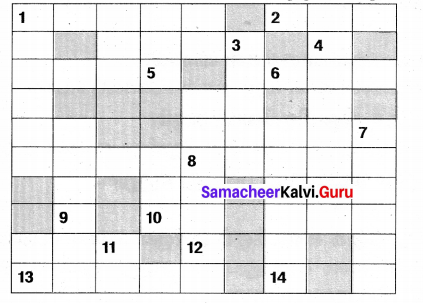
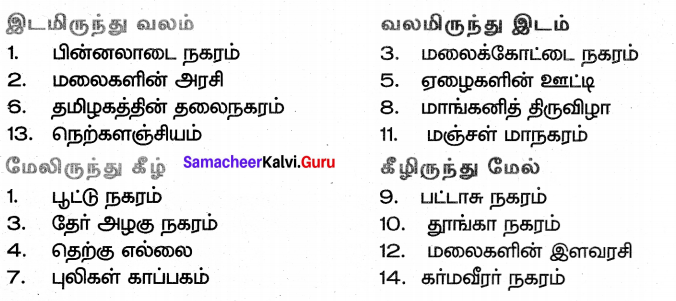
Answer:
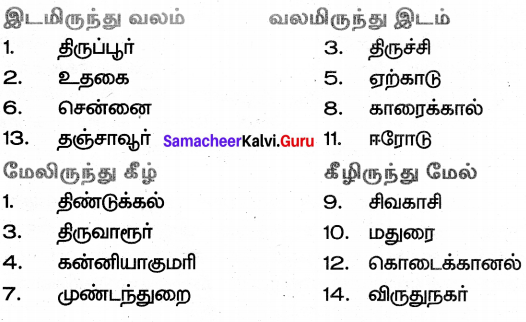
தொடருக்குப் பொருத்தமான உவமையை எடுத்து எழுதுக
Question 1.
என் தாயார் என்னை ……………. காத்து வளர்த்தார்.
(கண்ணை இமை காப்பது போல/ தாயைக் கண்ட சேயைப் போல)
Answer:
கண்ணை இமை காப்பது போல
Question 2.
நானும் என் தோழியும் ……………… இணைந்து இருப்போம்.
(இஞ்சி தின்ற குரங்கு 9 போல/ நகமும் சதையும் போல)
Answer:
நகமும் சதையும் போல
Question 3.
திருவள்ளுவரின் புகழை ………….. உலகமே அறிந்துள்ளது.
(எலியும் பூனையும் போல/ உள்ளங்கை நெல்லிக்கனி போல)
Answer:
உள்ளங்கை நெல்லிக்கனி போல
Question 4.
அப்துல் கலாமின் புகழ் ………………… உலகெங்கும் பரவியது.
(குன்றி மேலிட்ட விளக்கு
போல/ குடத்துள் இட்ட விளக்கு போல)
Answer:
குன்றின் மேலிட்ட விளக்கு போல
Question 5.
சிறு வயதில் நான் பார்த்த நிகழ்ச்சிகள். ………….. என் மனத்தில் பதிந்தன.
(கிணற்றுத்தவளை போல/ பசுமரத்தாணி போல)
Answer:
பசுமரத்தாணி போல
கொடுக்கப்பட்டுள்ள ஊரின் பெயர்களில் இருந்து புதிய சொற்களை உருவாக்குக
(எ.கா.) திருநெல்வேலி – திரு, நெல், வேலி, வேல்
1. நாகப்பட்டினம் – நாகம், பட்டினம், படி, பட்டி, கப்பம், நாடி, நா
2. கன்னியாகுமரி – கன்னி, குமரி, கனி, கரி, யா, கயா
3. செங்கல்பட்டு – செங்கல், பட்டு, படு, செல், பல், கல், பகல், பகட்டு
4. உதகமண்டலம் – மண், மண்டலம், மடம், உண், கண், தடம், கமண்ட லம், கடம்
5. பட்டுக்கோட்டை – பட்டு, கோட்டை, கோடை, படை, பட்டை, கோ, கோடு
நிற்க அதற்குத் தக
என் பொறுப்புகள்
1. நகரங்களின் சிறப்புத் தன்மையை அறிந்து போற்றுவேன்.
2. ஒவ்வொரு ஊரிலும் நடைபெறும் தொழில்களின் சிறப்பை அறிந்து தொழில் செய்வோரை மதிப்பேன்.
கலைச்சொல் அறிவோம்



